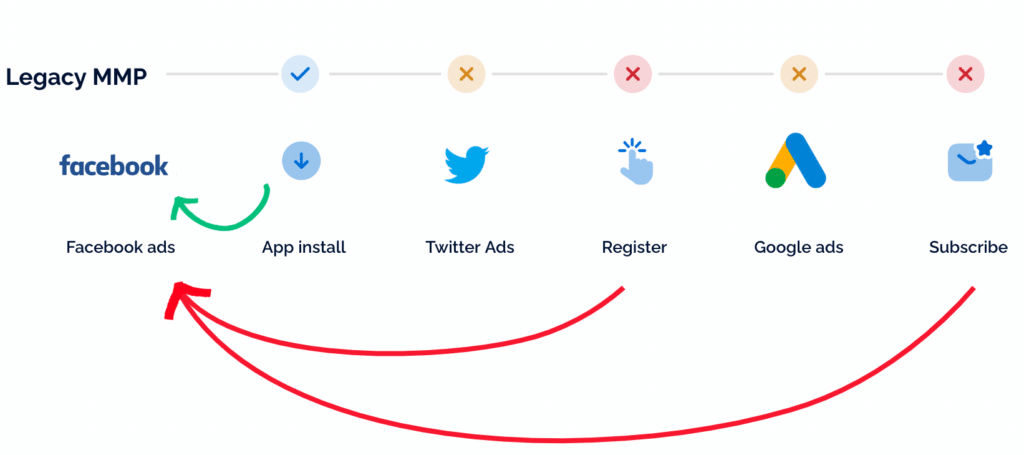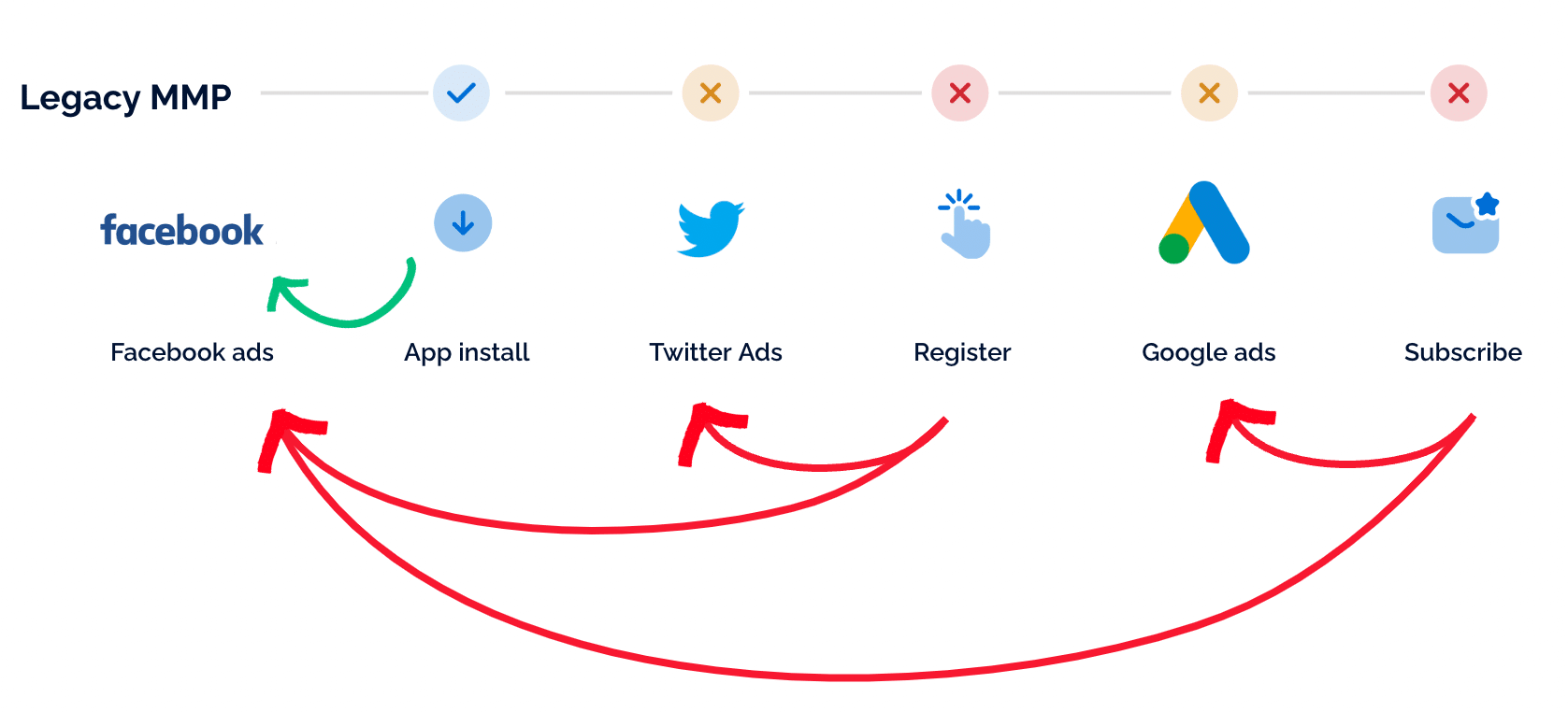You’ve probably come across the terms “last-touch attribution” (LTA) and “install-touch attribution” (ITA). But many mobile marketers don’t always know which type is best. Here, we examine the differences between LTA and ITA and explain why last-touch attribution is the best method to use.
We’ll cover:
- Common attribution methods used today
- How install touch developed and whether it’s still useful
- The difference between last-touch and install-touch attribution
- How to understand the contribution and impact of all your campaigns
Which attribution methods are most common?
Attribution is the process of crediting a source with a particular action or event. Gathering this data is useful primarily because it helps the marketer measure their various marketing channels’ success rates so they can better understand consumer behavior. The method used to gather this attribution data is equally important.
The most common types of attribution are forms of either multi-touch or single-touch attribution. With multi-touch attribution, credit is given to a number of different “touches,” or interactions, with a brand. When using single-touch attribution, only one of those touches — typically the one determined to be most important — is credited.
Methods of multi-touch attribution
- Linear attribution. Splits conversion credit equally among all campaign touchpoints.
- Time decay attribution. Spreads credit out over each touchpoint with consideration to when each touchpoint occurred. Applies the most credit to the most recent touchpoint and the least credit to the first touchpoint.
- U-shape attribution. Applies the most credit to the first and last touchpoint, while applying the least credit to touchpoints encountered in the middle.
As not every touchpoint is created equal, utilizing multi-touch attribution methods can harm accuracy since there is no weight toward more impactful activities. More importantly, multi-touch attribution is problematic in today’s age of privacy.
The problem with multi-touch attribution
In the world of cross-platform mobile advertising, multi-touch attribution used to be referred to as “the Holy Grail.” It attempts to show marketers each touchpoint that led a consumer to action. While this sounds good on paper, multi-touch attribution is problematic.
“Multi-touch attribution requires the ability to track individual consumers across multiple channels through a stable concept of identity over time,” explains Branch Senior Product Marketing Manager Amanda Vandiver. However, this has become increasingly difficult to execute due to recent shifts in privacy.
“Platforms are limiting access and [thus the] ability to understand identity,” Vandiver adds. “Device identifiers are going away.” Without a clear idea of who an individual is and how they interact with your brand across platforms and over a period of time, multi-touch attribution breaks and is unreliable.
Alternatives to multi-touch attribution
This brings us to single-touch attribution, which relies less on a concept of stable identity. The most common types of single-touch attribution are:
- First-touch attribution. Gives 100% conversion credit to the first “touch” a user had with your brand before the conversion event. This method can attribute too much credit to bringing a user into the funnel and ignore activities that inspire conversions.
- Install-touch attribution (ITA). This method gives 100% conversion credit to the last touch a user had with your brand before installing your mobile app. Install-touch attribution has a systemic bias toward install ads at the expense of engagement ads or owned and earned marketing activities. This method is useful if all you care about is an app download.
- Last-touch attribution (LTA). This method gives 100% conversion credit to the event responsible for a user’s last click or impression before converting. This method is most useful if you care about what drives users to act, whether that’s engaging with your app or purchasing your products.
Last-touch attribution has become one of the most commonly adopted methods used today, especially in mobile. However, what many mobile measurement partners (MMPs) present as last-touch attribution is actually install-touch attribution.
How install-touch attribution developed and why it’s not useful
Install touch worked really well years ago when the only conversion event that mattered was a mobile app install. It still works today for industries like gaming where the app install remains the end goal. But for most industries, getting an app install is not enough anymore. This means install-touch attribution is also not enough.
Now consumers have hundreds of apps to choose from — and just because they’ve installed your app doesn’t mean they’ll start, or continue, using it. What’s important for apps today is not just the install, but the activation and retention of users to better measure their lifetime value (LTV). You’ll want to pay attention to whether those installs are actually good.
The impact of bad data from install-touch attribution
The impact and damage of misattribution on retention is significant. Without true last-touch attribution, you might not see the value of a campaign touch that occurs after the install. This means you may make a business decision based on bad data.
Possible outcomes:
For example, you might decide not to continue investing in network B that did drive conversions while doubling down on network A that didn’t, resulting in lost conversions moving forward.
If this continues, you will see a long-term negative impact in your LTVs, retention curve, and more.
Ultimately, install touch only reflects one point in time. But, by using last touch and giving credit to the campaign that drove the conversion rather than the campaign that drove the install, you can ensure you’ll see the entire picture.
Metrics like conversion, revenue, retention, engagement, and LTV will all be taken into account. This, in turn, will allow you to make better business decisions that will positively impact your ROI.
Using cohort analytics to improve install-touch attribution
While there are some reasons install touch may be preferable for some businesses — such as estimating the LTVs brought in by a specific channel — you’re still being forced to use inaccurate data. However, Branch’s cohort analytics solves this problem.
Cohorting can be used not only to get an install-touch view but also to compare install touch with last touch. So, if measuring LTV is your goal, you can still do this through cohorting — just without all the unnecessary inaccuracies and inefficiencies.
Understand the impact of all your campaigns with last-touch attribution
Understanding which campaign to give credit to is vital. Give credit to the wrong campaign and your data becomes inaccurate, leading to critical errors in business decisions and spending.
For example, a user taps a Facebook ad, installs the app, and then fails to perform any additional action. They then encounter a Twitter ad that causes them to register, and then a Google ad that causes them to subscribe. Install-touch attribution will incorrectly credit the original Facebook ad for that subscribing moment.
This will likely result in a marketer turning off the Twitter and Google ads because they will appear ineffective. This hurts overall conversions as well as your data reporting, business decisions, and revenue. Suddenly, it will look like Facebook is not performing as well, either.
Why re-engagement attribution doesn’t work
Re-engagement attribution is sometimes suggested as a solution for understanding campaign performance. But, in actuality, it’s a temporary fix that makes the situation more complex in the long run. That’s because conversions are attributed in two different places simultaneously. In our example, extra conversions are being falsely reported to Facebook that are already being attributed elsewhere.
With re-engagement attribution, there are two different attribution windows opening: a click-to-install window and a reattribution window. This results in all post-install conversions being attributed to two different touch points — one to the install source (Facebook) and another to the post-install source (Twitter and Google).
Why is this bad? This type of attribution generates data in siloed dashboards so marketers can’t analyze the true source or get a comprehensive view of attribution. Even worse, if the reattribution window expires, those later events will be misattributed as unknown or organic.
Why last-touch attribution is better
With last-touch attribution, you can identify the true performance of paid ads, CRM, and in-house channels without further data processing. Since the last touch is not limited to the install, it’s possible to properly measure retargeting campaign performance, CRM channels, and more. This provides a more accurate view of which campaigns are driving the metrics that matter — when users register, and when they subscribe.
True last-touch attribution is the only method that correctly attributes events based on the last touch that drove them, which improves accuracy in reporting and decisions. And Branch is the only MMP that offers true last-touch attribution by default. We understand brands that run cross-channel campaigns across multiple platforms, and we’ve built a system that suits those needs. We also allow you to use the same links for acquisition and re-engagement campaigns.
Last-touch attribution delivers accurate and trustworthy data
In choosing the right attribution method for your brand, consider each method’s functionality and capacity for accuracy. The more accurate your data, the better informed your business decisions will be. Install touch used to be successful but isn’t sufficient anymore. And while multi-touch attribution can be valuable when technically possible, the concept of identity is muddy on mobile, and it’s better to rely on predictable attribution data.
We believe last-touch attribution is the best option. That’s because today’s mobile marketers care about more than just the install, and last-touch attribution provides a more accurate view of which campaigns are driving conversions.
Branch offers true last-touch attribution by default, enabling you to give credit to touch points that directly drove conversions — including but not limited to installs. We also make measuring the delta between install touch and last touch available through cohorts and also offer install touch for brands who need to use it for certain scenarios.
Start collecting attribution with the most accurate and trustworthy method out there. To learn more, watch our LTA vs. ITA webinar.

























